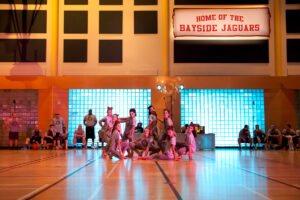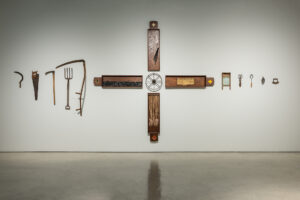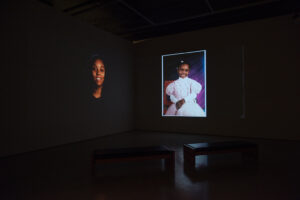- Home
- Exhibitions + Displays
- Love Languages
Love Languages
June 20, 2024 - October 27, 2024
Second Floor

Image: At Top: Joi T. Arcand’s ē-kī-nōhtē-itakot opwātisimowiskwēw (she used to want to be a fancy dancer) (2019), neon channel sign, 596 x 53 x 6 cm. Collection of the University of Saskatchewan. Purchase, 2019.
At Bottom: she used to want to be a ballerina (for grandma Vivian) (2019), photographic lightboxes, Collection of Indigenous Art Centre, CIRNAC.
Photo by Frank Piccolo
Love Languages is a group exhibition that equates artistic production to love. The artworks in the exhibition are all connected through language, text and graphic icons that convey profound meanings. The artists – including Jaime Angelopoulos, Joi T. Arcand, Michael Belmore, Susan Blight, David Bobier, Erika DeFreitas, Ed Janzen + Collette Broeders, Laura Moore, Sanaz Mazinani and Mani Mazinani, Anne Riley – each assigned their work a quality that aligns with their intentions. The five love languages are a means to understand ourselves and how we want to give and receive love. This exhibition questions, what are the artists’ motives and artistic drivers and who is the intended audience? Are you attracted to a particular work because it speaks to you and how you want to be loved?
This exhibition is about love, which is at the heart of every creation.
Words of affirmation: This love language involves expressing love and appreciation through verbal or written affirmations, such as compliments, praise, and love notes.
Quality time: This love language involves giving someone your undivided attention and spending time together doing activities you both enjoy.
Receiving gifts: This love language involves expressing love through gifts, whether they are small or significant. It’s not about the gift’s value, but rather the thought and effort behind it.
Acts of service: This love language involves expressing love through actions, such as doing chores, cooking a meal, or helping out with tasks.
Physical touch: This love language involves expressing love through physical touch, such as hugs, holding hands, or cuddling.
Curated by Julie Rae Tucker.
With works by: Jaime Angelopoulos, Joi T. Arcand, Michael Belmore, Susan Blight, David Bobier, Erika DeFreitas, Ed Janzen + Collette Broeders, Laura Moore, Sanaz Mazinani and Mani Mazinani and Anne Riley.
Gary Chapman’s 1992 book, The 5 Love Languages; How to Express Heartfelt Commitment to your Mate spawned a self-help empire. Multiple versions of the book have been published, encouraging people to reflect on how love is shared and received in relationships. This exhibition’s title is a playful response to the popular text, expanding from narrow definitions of relationships in Chapman’s work to ways that love is expressed through artistic practices that address care, community, and culture.





